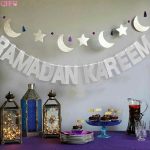Henna Ramadan: Unveiling The Exquisite Art For Your Festive Celebrations!
Henna Ramadan: Embracing Traditions in a Festive Season
Introduction
Assalamualaikum, Ramadhan enthusiasts and lovers! As we approach the holy month of Ramadan, our hearts are filled with excitement and anticipation. This sacred time of the year brings numerous customs and traditions that truly make it a unique and joyous occasion. One such tradition that holds a special place in our hearts is Henna Ramadan. In this article, we will delve into the enchanting world of henna and explore its significance during the Ramadan season.
1 Picture Gallery: Henna Ramadan: Unveiling The Exquisite Art For Your Festive Celebrations!

Before we dive into the artistry of henna and its connection to Ramadan, let’s first understand what henna is and how it has become an integral part of our culture and celebrations.

Image Source: pinimg.com
Henna, also known as Mehndi, is a natural dye made from the leaves of the henna plant. It is commonly used to adorn the hands and feet with intricate designs, symbolizing joy, beauty, and blessings. The application of henna is a cherished practice in many cultures, including those celebrating Ramadan.
Now, let’s explore the various aspects of henna Ramadan and discover the reasons behind its widespread popularity and significance.
What is Henna Ramadan?
During the month of Ramadan, the art of henna takes on a special meaning and is intricately woven into the fabric of our festivities. Henna Ramadan refers to the application of henna designs during this blessed month. It is a way for individuals to express their joy and devotion as they engage in acts of worship and reflection.
The designs created during Henna Ramadan are often inspired by traditional patterns and symbols that hold spiritual significance. These intricate motifs not only beautify the hands but also serve as a reminder of the values and teachings upheld during Ramadan.
Throughout the month, henna artists are in high demand as people flock to get their hands adorned with beautiful henna designs. From simple and elegant patterns to elaborate and ornate creations, each henna design carries its own unique charm and represents the individual’s personal connection to Ramadan.
Who Participates in Henna Ramadan?
Henna Ramadan is embraced by individuals of all ages and backgrounds. It is a unifying tradition that brings communities together in celebration and devotion. From young children to elderly members, everyone eagerly joins in the festivities and indulges in the beauty of henna.
For women, in particular, Henna Ramadan holds a special significance. It is a time when women gather to share their skills and create mesmerizing henna designs on each other’s hands. This bonding experience fosters a sense of community and strengthens the spiritual connections among women during this holy month.
However, it’s important to note that Henna Ramadan is not limited to any specific gender or age group. People of all genders and ages can partake in the joyous tradition and delight in the enchanting artistry of henna.
When and Where to Experience Henna Ramadan?
Henna Ramadan can be experienced throughout the month of Ramadan, with the peak of its popularity during the nights of Taraweeh prayers and other special occasions, such as iftar gatherings and Eid celebrations. Mosques, community centers, and even individual homes become vibrant hubs where henna artists showcase their talent and individuals have the opportunity to have their hands adorned.
Not only can you witness the beauty of henna Ramadan in your local community, but social media platforms have also become a hub for henna enthusiasts to share their designs and experiences. Various online platforms offer tutorials and inspiration for those who wish to create their own henna designs at home.
Why is Henna Ramadan Significant?
Henna Ramadan holds immense significance for many reasons. Firstly, it is a form of self-expression and celebration during the holy month of Ramadan. As we abstain from food and drink during the day, henna becomes a way to find joy and express our creativity.
Moreover, henna designs often incorporate symbols and motifs that represent various aspects of Ramadan, such as the crescent moon, stars, and Arabic calligraphy. These symbols serve as a constant reminder of our faith and the values we strive to uphold during this blessed month.
Additionally, the application of henna is believed to have cooling properties, providing relief during the long hours of fasting. It is also seen as a form of blessing and protection, warding off evil and bringing good fortune to the wearer.
How to Create Henna Designs for Ramadan?
Creating henna designs for Ramadan can be a truly rewarding experience. If you wish to try your hand at this art form, here are some steps to get you started:
Start by preparing the henna paste using high-quality henna powder, lemon juice, and essential oils.
Carefully apply the henna paste onto your skin using a cone or a henna applicator.
Allow the henna to dry for a few hours or overnight, depending on the desired intensity of the color.
Once the henna is dry, gently scrape off the dried paste, revealing the beautiful reddish-brown stain underneath.
To enhance the color and longevity of the design, avoid contact with water for at least 24 hours.
Enjoy the exquisite beauty of your henna design throughout the month of Ramadan!
Advantages and Disadvantages of Henna Ramadan
Just like any tradition, Henna Ramadan comes with its own set of advantages and disadvantages. Let’s explore both sides:
Advantages:
1. Cultural Preservation: Henna Ramadan plays a significant role in preserving cultural traditions and celebrations during the holy month of Ramadan.
2. Self-Expression: The art of henna allows individuals to express their creativity and personal connection to Ramadan.
3. Community Bonding: Henna Ramadan brings communities together, fostering a sense of togetherness and unity.
4. Spiritual Significance: The symbols and motifs used in henna designs hold spiritual significance, serving as a constant reminder of the values upheld during Ramadan.
5. Cooling Effect: The application of henna is believed to have a cooling effect, providing relief during the long hours of fasting.
Disadvantages:
1. Allergic Reactions: Some individuals may experience allergic reactions to henna, resulting in skin irritation or other complications.
2. Time-Consuming: Creating intricate henna designs can be time-consuming, requiring patience and dedication.
3. Limited Durability: The henna stain gradually fades over time, and the design may not retain its initial vibrancy throughout the entire month of Ramadan.
4. Cultural Appropriation: It is important to respect the cultural significance of henna and avoid appropriating it without proper understanding and appreciation.
Frequently Asked Questions (FAQs)
1. Can henna be applied while fasting?
Yes, henna can be applied while fasting as it does not invalidate the fast. However, care should be taken to avoid ingesting any henna paste accidentally.
2. How long does the henna stain last?
The duration of the henna stain varies from person to person and depends on several factors such as skin type, aftercare, and the quality of the henna paste. On average, the stain lasts between one to three weeks.
3. Are there any religious restrictions regarding henna during Ramadan?
No, there are no religious restrictions regarding the application of henna during Ramadan. It is a cultural tradition that is widely embraced by Muslims around the world.
4. Can henna be used on hair during Ramadan?
While henna is commonly used as a natural hair dye, it is advised to avoid applying it during the daytime while fasting. It is preferable to apply henna on the hair after breaking the fast to ensure it does not come in contact with the mouth or accidentally ingested.
5. What should I do if I have an allergic reaction to henna?
If you experience an allergic reaction to henna, such as severe itching, redness, or swelling, it is recommended to seek medical advice and discontinue its use. It’s always best to perform a patch test before applying henna to ensure you are not allergic to it.
Conclusion
In conclusion, Henna Ramadan is a cherished tradition that adds vibrancy and beauty to the holy month of Ramadan. It allows individuals to express their creativity, share in the joyous festivities, and strengthen their connection to their faith. Whether you choose to adorn your hands with henna designs or appreciate the artistry from afar, Henna Ramadan is a celebration of unity, tradition, and the spirit of Ramadan.
Final Remarks
These insights into Henna Ramadan are intended to provide a glimpse into the rich traditions and cultural practices that make Ramadan a truly special time of the year. It is important to approach these traditions with respect and understanding, appreciating the beauty they bring to our lives. May this Ramadan be a blessed and joyous time for all. Ramadan Mubarak!
This post topic: Ramadhan

